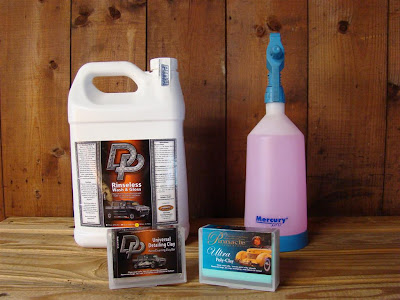How To Properly Clay A Vehicle
There are many different brands of clays with varying degrees of aggressiveness. To determine what kind of clay is required for a vehicle, it is recommended that the “plastic bag test” be used. After the vehicle in question is washed and dried, place your hand in a plastic sandwich bag and gently rub the paint with your fingertips. If the surface feels rough and the plastic bag does not freely glide of the surface the vehicle needs to be clayed. Typically a vehicle will only need to be clayed every six months to keep it free of embedded contaminants. If these contaminants are left unattended over time, they will cause a vehicle’s paint to rust from the inside out. These tiny rust spots are know as “rust blooms” and are especially visible on white and silver colored vehicles. Claying not only removes embedded contaminants preventing permanent damage, but it increases the durability of waxes and sealants.
Procedure
1. Cut the clay bar into two or four pieces depending on how many ounces it is. On average, only two ounces of clay is required to completely clean a vehicle.
2. It is important to use a quality clay lube to prevent accidental damage while claying. Apply liberal amounts of clay lube to a two square foot area and gently rub the clay in a slow back and forth motion. Start by claying the roof of the vehicle and work down to the rocker panels. At first the clay will grab the surface. This is completely normal as it means that embedded contamination is being removed.
3. After claying each section, it is important to inspect the clay bar and kneed the clay until a clean surface is revealed. There is no set number of panels or vehicles that a single piece of clay can be used on. When the clay no longer has any clean surface area left, it is time to discard it and use another piece. (Note: If the clay bar is dropped on the ground it should be discarded immediately. It is not worth risking thousands of dollars in paint damage to save a few dollars.)
4. Wash the vehicle with an automotive shampoo using the two bucket method to remove any clay residue. After drying the vehicle, it is important to apply a wax or sealant to the vehicle to protect it from the elements. (Note: The clay bar process removes any protection on a vehicle.)
1. Cut the clay bar into two or four pieces depending on how many ounces it is. On average, only two ounces of clay is required to completely clean a vehicle.
2. It is important to use a quality clay lube to prevent accidental damage while claying. Apply liberal amounts of clay lube to a two square foot area and gently rub the clay in a slow back and forth motion. Start by claying the roof of the vehicle and work down to the rocker panels. At first the clay will grab the surface. This is completely normal as it means that embedded contamination is being removed.
3. After claying each section, it is important to inspect the clay bar and kneed the clay until a clean surface is revealed. There is no set number of panels or vehicles that a single piece of clay can be used on. When the clay no longer has any clean surface area left, it is time to discard it and use another piece. (Note: If the clay bar is dropped on the ground it should be discarded immediately. It is not worth risking thousands of dollars in paint damage to save a few dollars.)
4. Wash the vehicle with an automotive shampoo using the two bucket method to remove any clay residue. After drying the vehicle, it is important to apply a wax or sealant to the vehicle to protect it from the elements. (Note: The clay bar process removes any protection on a vehicle.)
Products and Procedures
Clay Bar
Clay Lube
One liter spray bottle


